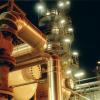|
|
High Corrosion Rate In Mdea Lean Circuit
#1

Posted 15 August 2008 - 01:00 AM
parameters are almost same and under well controlled. It has just jumped from 4 to 12 mpy in last 6 monthe. Our filtration is working properly, reboiler temperature is well controlled, degradiation is very less. What may be the other reasons and what is the precautionery action I shpould take.
Besat regards.
#2

Posted 20 August 2008 - 05:01 AM
I suggest you check your chlorides level in your amine. if they are high, then you need to get them down (to < 500 ppm). you can do the following:
1) Check your water maker to make sure that water quality is very high (very low chlorides ppm) and fix if necessary
2) Consider installing an amine purification unit on a slip stream. Check the following site for one vendor (We have used this one in a BP plant in the UAE)
http://www.eco-tec.c..._processing.php
3) Consider replacing your amine as necessary to bring the chlorides level to < 500 ppm.
I hope this helps.
#3

Posted 21 August 2008 - 09:13 AM
What has been your experience with Eco-Tec, HMAlmosa? Do they work well? Are the units reliable?
#4

Posted 22 August 2008 - 07:50 AM
We are using steam condensate for solvent dilution.
Degradiation products in lean amine is vey low( 0.012%).
Regards.
#5

Posted 24 August 2008 - 01:16 AM
May pl go through it if u can get a copy of that.
#6

Posted 24 August 2008 - 01:16 PM
If you have any electronic copy please attach it .
Thak you for your time.
Best regards.
#7

Posted 25 August 2008 - 12:55 AM
#8

Posted 25 August 2008 - 08:17 AM
Best regards.
#9

Posted 26 August 2008 - 04:49 AM
Best Regards
Qalander
#10

Posted 26 August 2008 - 06:13 AM
Various amine/service vendors offer both on-line and off-site amine reclaiming services. Several factors must be considered when evaluating the need for reclaiming the amine solution for HSS removal. The proper amine reclaiming option for HSS removal frequently balances the following key factors:
1) Economic considerations. The operator must be aware of hidden cost associated with each amine reclaiming option, i.e. regeneration chemical requirements, transportation costs, energy requirements or disposal costs.
2) Disposal of waste/by-product streams. If the refinery wastewater facility can not tolerate the waste stream generated by the reclaiming process then obviously, off-site reclaiming is likely the best option.
3) HSS incursion rate. Low HSS incursion rate amine systems are not likely candidates for frequent on-line reclaiming but amine systems with a high HSS incursion rate require a closer review of the system reclaiming requirements and frequency of treatment.
Electrodialysis Reclamation - Electrodialysis units are stacks of membranes that allow selective passage of anions and cations through the membrane media under an electrical field. These units separate the HSS contaminated amine solution into two effluent streams, (1) a reclaimed amine stream and (2) a brine waste stream containing the HSS anions and sodium (Na) or potassium (K) cations, if alkali is utilized to "neutralize" the HSS. The electrodialysis units appear to work best in systems with a high level of HSS contamination. The brine effluent stream typically contains some amine. This effluent stream may contain enough amine to cause problems in the refinery wastewater treatment facility.
Vacuum Distillation Reclamation - A proprietary vacuum distillation process utilizes a caustic
neutralization pretreatment step to neutralize the bound acids followed by distillation under a vacuum to remove the converted salts. The principal advantage of the vacuum distillation process is derived from the unit's ability to concentrate the amine solution in the effluent, thus effectively; de-watering the HSS contaminated solution as well as reducing the HSS anion content. The process is energy intensive and thus can be expensive. Disposal of waste streams may also be a potential obstacle.
Ion Exchange Reclamation (ECO-Tech - AMIPUR) - Ion exchange uses anion and cation resins to replace the HSS ions and sodium/potassium with water. The process produces no solid waste. Ion exchange does require a substantial amount of regeneration chemicals, but the waste streams are generally compatible with existing wastewater treatment facilities.
#11

Posted 26 August 2008 - 11:24 PM
thank you
#12

Posted 27 August 2008 - 12:06 AM
Nice practical evaluating info is appreciable.
regards
Qalander
#13

Posted 27 August 2008 - 04:17 PM
My email address is as below. Could you kindly mail me the article.
Kind regards,
satyajit
smpatra@hotmail.com
#14

Posted 30 August 2008 - 10:36 AM
Here, I upload one of severals technical papers regarding corrosion in amine sysytems.
Worth reading.
Regards.
Attached Files
#15

Posted 30 August 2008 - 09:54 PM
http://www.gastreati.....-May 1993.pdf
http://www.reclaim.c...as_treating.pdf
http://www.shell.com...ne_solvents.pdf
#16

Posted 31 August 2008 - 10:47 AM
Thanks for the valuable links to understand the problem in Amine treating units. Nowadays, we also face the same problem.
Best regards
Toor
#17

Posted 31 August 2008 - 11:13 PM
Hello/Good Morning,
I really appreciate the shared info being very pertinent and helpful in the present days of 'Heavy and more sour crude oil's inevitable processing' and 'Even much more sour Natural Gas Resources utilization becoming a routine as well'
Best Regards
Qalander
#18

Posted 01 July 2010 - 07:07 AM
I would appreciate if you can send the paper to junaid.shaikh@marigas.com.pk
#19

Posted 02 August 2010 - 02:28 AM
Just for additional info, some consideration that I've been taken account
on designing the MDEA gas sweetening unit, taken from BP Amoco Treatment Handbook
Recommendations to Minimise Corrosion Rates and Foaming
1. Minimise hydrocarbon contamination
Action:
The temperature of the lean amine entering the absorber
should be above the dew point of the inlet gas
temperature to prevent condensation of hydrocarbons in
the absorber.
A knock-out drum should be located close to the absorber
inlet to remove any entrained and condensing
hydrocarbons in the gas.
Install carbon filter and replace activated carbon every 6
to 9 months
Install properly designed rich amine flash drum
2. Minimise corrosion
Acid gas loadings should not exceed the recommended
values.
See attachment
Minimise all possible sources of oxygen ingress
including;
- with fresh amine: ensure effective nitrogen blanketing
of amine make-up tanks
- with make-up water: must be de-aerated
- direct ingress through pump seals, pipe flanges, etc.
- in acid gas from FCCU.
Velocities of amine solutions should not exceed 1.8 m/s
to minimise the risk of eroding the protective film of FeS.
3. Minimise amine degradation
Avoid excessive reboiler temperature (max 130°C).
Desuperheat the steam to the reboiler and control the
steam flow not the condensate leaving the reboiler
Avoid over stripping the lean amine
Install carbon filter and replace activated carbon every 6
to 9 months
4. Minimise particulates
Provide high quality filtration to remove fine particulates
of Fe2O3, FeS and Fe2(CO2)3
Do not exceed recommended acid gas loadings and amine
concentration.
See attachment
5. Minimise NH4HS in reflux drum
Water wash hydrotreater offgas.
Purge reflux drum to sour water stripper.
6. Minimise heat stable salts
Water wash FCCU offgas
Monitor and control heat stable salts
Attached Files
#20

Posted 13 August 2010 - 01:48 PM
In our MDEA system lean amine circuit, it is onserved higher corrosion rate , although all the
parameters are almost same and under well controlled. It has just jumped from 4 to 12 mpy in last 6 monthe. Our filtration is working properly, reboiler temperature is well controlled, degradiation is very less. What may be the other reasons and what is the precautionery action I shpould take.
Besat regards.
Check the following :
1. Required concentration may not be maintained which lead to higher loading of CO2. this lead to corrossion
2. formation of formic acid. Anaylse for it
3. Replace the carbon steel packing in the stripper with SS packing if applicable
hope it helps
Similar Topics
High Stack Temperature In Ccr HeatersStarted by Guest_viba0124_* , 30 Nov 2024 |
|

|
||
How To Estimate The Circulation Rate For Amdea (Mdea 45Wt + Pz 5Wt) BeStarted by Guest_tokotof_* , 29 Nov 2024 |
|

|
||
Molecular Sieve Regeneration At High PressureStarted by Guest_Victor_process_Engineer_* , 07 Jan 2025 |
|

|
||
Psv Release Rate Vs TimeStarted by Guest_stu_* , 30 Nov 2024 |
|

|
||
Relieving Flow Rate In Terms Of Air EquivalentStarted by Guest_go-fish_* , 21 Nov 2024 |
|

|

 FB
FB











